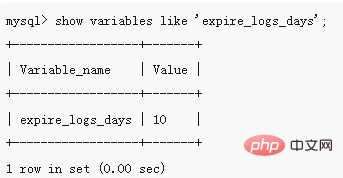How to delete binary log in mysql
3 methods: 1. Delete all logs with the syntax "RESET MASTER;". After deletion, new binary logs will be created again; 2. Delete logs according to the number with the syntax "PURGE MASTER LOGS TO ' file name.number';", all binary logs with numbers less than the specified "number'" will be deleted; 3. Delete logs based on the creation time, the syntax is "PURGE MASTER LOGS TO 'yyyy-mm-dd hh:MM:ss';".

The operating environment of this tutorial: windows7 system, mysql8 version, Dell G3 computer.
Mysql method of deleting binary logs
After the binary log is started, a new binary log file will be generated every time the MySQL service is restarted. .
The binary log records a large amount of information. If the binary log is not cleaned for a long time, a lot of disk space will be wasted. There are many ways to delete binary logs. Here are several ways to delete binary logs.
Method 1: Delete all binary logs
Use the RESET MASTER statement to delete all binary logs. The form of the statement is as follows:
RESET MASTER;
Log in After opening the MySQL database, you can execute this statement to delete all binary logs. After all binary logs are deleted, MySQL will re-create new binary logs with numbers starting from 000001.
Method 2: Delete binary logs based on number
Each binary log file is followed by a 6-digit number, such as 000001. Logs up to the specified binary log number can be deleted using the PURGE MASTER LOGS TO statement. The basic syntax form of this statement is as follows:
PURGE MASTER LOGS TO 'filename.number';
This statement will delete all binary logs with numbers less than filename.number.
Example:
//删除bin-log.000002之前的二进制日志 purge binary logs to 'bin-log.000002';

Method 3: Delete binary logs based on creation time
Use PURGE The MASTER LOGS TO statement can delete binary logs created before the specified time. The basic syntax format of this statement is as follows:
PURGE MASTER LOGS TO 'yyyy-mm-dd hh:MM:ss';
where "hh" is the 24-hour hour. This statement will delete all binary logs created before the specified time.
Example: Delete the binary log created before 2019-12-20 15:00:00
PURGE MASTER LOGS TO '2019-12-20 15:00:00";
After the code is executed, all the binary logs created before 2019-12-20 15:00:00 Binary logs will be deleted.

In addition, we can also set the expire_logs_days parameter to set automatic cleanup. Its default value is 0, which means that the expired automatic deletion function is not enabled.
show variables like 'expire_logs_days';

If the automatic cleaning function is enabled, binary log files that exceed this number of days will be automatically deleted. Automatic deletion usually occurs when MySQL starts or when FLUSH logs are flushed.

[Related recommendations: mysql video tutorial]
The above is the detailed content of How to delete binary log in mysql. For more information, please follow other related articles on the PHP Chinese website!

Hot AI Tools

Undresser.AI Undress
AI-powered app for creating realistic nude photos

AI Clothes Remover
Online AI tool for removing clothes from photos.

Undress AI Tool
Undress images for free

Clothoff.io
AI clothes remover

Video Face Swap
Swap faces in any video effortlessly with our completely free AI face swap tool!

Hot Article

Hot Tools

Notepad++7.3.1
Easy-to-use and free code editor

SublimeText3 Chinese version
Chinese version, very easy to use

Zend Studio 13.0.1
Powerful PHP integrated development environment

Dreamweaver CS6
Visual web development tools

SublimeText3 Mac version
God-level code editing software (SublimeText3)

Hot Topics
 1664
1664
 14
14
 1423
1423
 52
52
 1318
1318
 25
25
 1269
1269
 29
29
 1248
1248
 24
24
 MySQL's Role: Databases in Web Applications
Apr 17, 2025 am 12:23 AM
MySQL's Role: Databases in Web Applications
Apr 17, 2025 am 12:23 AM
The main role of MySQL in web applications is to store and manage data. 1.MySQL efficiently processes user information, product catalogs, transaction records and other data. 2. Through SQL query, developers can extract information from the database to generate dynamic content. 3.MySQL works based on the client-server model to ensure acceptable query speed.
 Laravel Introduction Example
Apr 18, 2025 pm 12:45 PM
Laravel Introduction Example
Apr 18, 2025 pm 12:45 PM
Laravel is a PHP framework for easy building of web applications. It provides a range of powerful features including: Installation: Install the Laravel CLI globally with Composer and create applications in the project directory. Routing: Define the relationship between the URL and the handler in routes/web.php. View: Create a view in resources/views to render the application's interface. Database Integration: Provides out-of-the-box integration with databases such as MySQL and uses migration to create and modify tables. Model and Controller: The model represents the database entity and the controller processes HTTP requests.
 MySQL and phpMyAdmin: Core Features and Functions
Apr 22, 2025 am 12:12 AM
MySQL and phpMyAdmin: Core Features and Functions
Apr 22, 2025 am 12:12 AM
MySQL and phpMyAdmin are powerful database management tools. 1) MySQL is used to create databases and tables, and to execute DML and SQL queries. 2) phpMyAdmin provides an intuitive interface for database management, table structure management, data operations and user permission management.
 MySQL vs. Other Programming Languages: A Comparison
Apr 19, 2025 am 12:22 AM
MySQL vs. Other Programming Languages: A Comparison
Apr 19, 2025 am 12:22 AM
Compared with other programming languages, MySQL is mainly used to store and manage data, while other languages such as Python, Java, and C are used for logical processing and application development. MySQL is known for its high performance, scalability and cross-platform support, suitable for data management needs, while other languages have advantages in their respective fields such as data analytics, enterprise applications, and system programming.
 Solve database connection problem: a practical case of using minii/db library
Apr 18, 2025 am 07:09 AM
Solve database connection problem: a practical case of using minii/db library
Apr 18, 2025 am 07:09 AM
I encountered a tricky problem when developing a small application: the need to quickly integrate a lightweight database operation library. After trying multiple libraries, I found that they either have too much functionality or are not very compatible. Eventually, I found minii/db, a simplified version based on Yii2 that solved my problem perfectly.
 Laravel framework installation method
Apr 18, 2025 pm 12:54 PM
Laravel framework installation method
Apr 18, 2025 pm 12:54 PM
Article summary: This article provides detailed step-by-step instructions to guide readers on how to easily install the Laravel framework. Laravel is a powerful PHP framework that speeds up the development process of web applications. This tutorial covers the installation process from system requirements to configuring databases and setting up routing. By following these steps, readers can quickly and efficiently lay a solid foundation for their Laravel project.
 MySQL for Beginners: Getting Started with Database Management
Apr 18, 2025 am 12:10 AM
MySQL for Beginners: Getting Started with Database Management
Apr 18, 2025 am 12:10 AM
The basic operations of MySQL include creating databases, tables, and using SQL to perform CRUD operations on data. 1. Create a database: CREATEDATABASEmy_first_db; 2. Create a table: CREATETABLEbooks(idINTAUTO_INCREMENTPRIMARYKEY, titleVARCHAR(100)NOTNULL, authorVARCHAR(100)NOTNULL, published_yearINT); 3. Insert data: INSERTINTObooks(title, author, published_year)VA
 Solve MySQL mode problem: The experience of using the TheliaMySQLModesChecker module
Apr 18, 2025 am 08:42 AM
Solve MySQL mode problem: The experience of using the TheliaMySQLModesChecker module
Apr 18, 2025 am 08:42 AM
When developing an e-commerce website using Thelia, I encountered a tricky problem: MySQL mode is not set properly, causing some features to not function properly. After some exploration, I found a module called TheliaMySQLModesChecker, which is able to automatically fix the MySQL pattern required by Thelia, completely solving my troubles.




